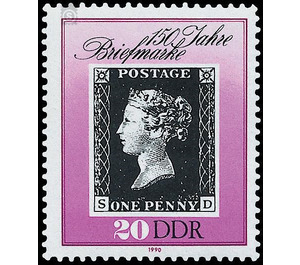150 years - Germany / German Democratic Republic 1990 - 20 Pfennig
Theme: Calender
| Country | Germany / German Democratic Republic |
| Issue Date | 1990 |
| Face Value | 20.00 |
| Color | black pink |
| Perforation | K 14 |
| Printing Type | offset |
| Stamp Type | Postage stamp |
| Item Type | Stamp |
| Chronological Issue Number | 3071 |
| Chronological Chapter | GER-DDR |
| SID | 754832 |
| In 19 Wishlists | |
150 years stamp The Ministry of Posts and Telecommunications of the German Democratic Republic issues three multicolored special postage stamps, one of them with supplement, with the pictures of historical stamps. The contract will be awarded to the Philatelistenverband der DDR. Special cancellation from 8th May to 7th July 1990 150th anniversary stamp In addition to the 500th anniversary of the Postal Service, "150 years postage stamp" is also celebrated in 1990, and it is commemorated in May 1840, when the first postage stamps in the world were donated to the United Kingdom Switch came. The German Post of the GDR honors this anniversary with three special values, which also reflect three chapters of stamp history. 20 Pfennig - Penny black from Great Britain 1840 In the 1920s and 30s of the 19th century, in the 1920s and 1930s, the United Kingdom repeatedly demanded a postal reform in the face of the industrial revolution and the growing need for fast and good communications. The later postmaster-general Rowland Hill (1795-1879) put off in 1837 in a famous memorandum on the "reform of the postal service, its meaning and feasibility" from the basic features of such a change. He proposed to abolish the hitherto very high postal charges and the very cumbersome billing after the removal of a consignment and the number of contained letterheads. Instead, should apply a uniform for the United Kingdom, independent of distances and especially cheap postage, the so-called penny-postage, which is staggered only by weight levels. At the same time, Hill suggested that the postage should no longer be paid by the recipient of a letter, as was customary until then, but the sender had to discharge the postage and, for this purpose, introduce postage stamps as an attachable receipt for prepaid transportation. After long and heated discussions, Hill's proposals, which were based on many precursors, came into force in January 1840. Accordingly, on May 1, 1840, the world's first stamps were sold to British post offices, and May 6, 150 years ago, was the first day of their franking validity. They were 1 penny in black and 2 pence in blue. They showed the head of the then just 21-year-old Queen Victoria with a crown and high hairstyle, which was not dissimilar to the much later ponytail fashion. The first two postage stamps were given in bows of 240 tokens, they were rubberized and had a small crown as a watermark. But they were not yet toothed, but had to be separated from the bows with scissors. For their devaluation, the British Post created special stamps in the form of a Maltese cross, which were to be cut off at the black mark in red and the blue in black. For today's feeling weirdly the letters in the lower mark corners. They allow an exact determination of the space of each mark in the 240-sheet, since the letters indicate on the bottom left one of the 20 horizontal rows (from A to T) and the letters on the bottom right one of the 12 vertical rows (A to L). The penny black now pictured on the GDR postal stamp is the fourth stamp in the 19th horizontal row with the combination SD. In addition to the value and the letters, the first stamps bore only the word "postage", but no country name - and this has remained so to this day on all United Kingdom stamps; The respective portrait of the monarch alone serves to identify their origin. And portrait: The portrait of the Queen Victoria remained for 60 years brand image in the UK. The queen died in 1901 at just under 82, but she had never aged on the stamps of her country.


